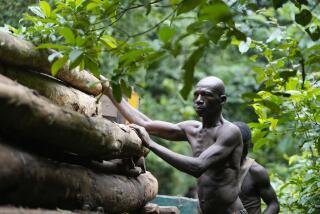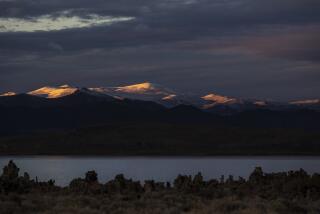Juggling Nature’s Demands to Protect the Refuge
- Share via
LAKE NAKURU NATIONAL PARK, Kenya — Alfred Mayoli has the air of a benevolent gnome, wears camouflage battle-dress and drives a 10-speed Land-Rover.
As chief game warden at Lake Nakuru National Park, he is in charge of preserving the park and its inhabitants.
The presence of black rhinos at Nakuru is symbolic of the fragility of the experiment Mayoli oversees. They don’t really belong here by the mirror-flat lake with its pelicans and flamingos. Until the park was stocked in 1987, there were never more than a few passing pachyderms in the region.
And the lake itself, 15 square miles, doesn’t really belong either, not in one of the most densely populated areas of a country with the fastest growing population in the world.
If Mayoli is to succeed in preserving the environment--and he’s the third chief warden to try in two years--he needs to juggle a difficult combination of factors: water supply, pollution control, local agriculture, animal populations and poaching.
Nakuru is no ordinary lake. Fed by three rivers, it has no natural outflow. It empties and fills mysteriously through the lake bed, and the water level has nothing to do with rainfall.
At the moment it is filling. What worries Mayoli and the Kenyan water department is that it may be filling with the wrong stuff.
The town of Nakuru, which sprawls right up to the north gate of the park, had just over half a million inhabitants in 1979. Pessimistic estimates say that figure has doubled, and with a new industrial sector, the town is easily using twice as much water.
The sewage system is in a state of collapse, and even if it were not, according to officials at the Ministry of Water Development, who declined identification, the sheer volume of water outflow from the town likely would seriously damage the lake.
Local agriculture and deforestation, meanwhile, is severely eroding the lands outside the park. Rainwater comes into the lake now, says Mayoli, through deep-cut gullies without passing through the soil and filtering itself.
“We are the recipients of the pesticides,” he says.
The food chain in Nakuru is dependent on the lake water maintaining an alkaline pH value of around 9.0, Mayoli says. A continuous influx of water of a different value could kill the billions of blue-green algae that form the basic diet of the fish and the million flamingos, which live in or on the water.
That in turn would put the 50 species of mammal and 450 species of birds in the park at serious risk.
Nakuru houses not just black rhino. It also has 104 rare Rothschild’s giraffes, between 80 and 100 leopards, five lions and almost 2,000 water buffalo, not to mention the swarms of waterbuck, wart hog and impala that clog the woodland to the south of the lake.
Those swarms in themselves are a further problem. The aim of the park since its foundation in 1961 has been to keep grazing populations in check with natural predators.
But with only five lions, Nakuru has a serious shortage of predators.
“If anyone has lions or leopards that are a nuisance, we will take them,” Mayoli says.
An abundance of edible game, he says, has attracted a different nuisance: local poaching to supplement food and to keep gazelles from eating crops.
Despite the fact that the park is double-fenced, local people may still believe that its inhabitants are straying and come through the fences themselves to deal with the problem.
“People do all sorts of sabotage if they are losing crops,” Mayoli says. “What we have to do is educate them about reporting game that is a nuisance.
“They also come through the fence to collect firewood and set snares,” he says.
But despite his multiple problems, the chief warden is optimistic. He has backing from the Kenya Wildlife Service under director Richard Leakey. He has funding from the Lake Nakuru Conservation and Development Trust, the Rhino Rescue Trust and the Worldwide Fund for Nature.
And the devolvement of the KWS from central government, due to be complete July 1 this year, will, he hopes, give him the funds to pursue his educational goals. All revenue from tourists visiting the parks will come back to the KWS. Nakuru last year had 170,000 visitors, more than any other park in the country. Since the introduction of the rhinos, it has almost tripled its revenue from $165,000 in 1986 to $420,000 in 1989.
Under Leakey’s direction, the plan is to plow roughly 25% of park income back into local communities to assist with building projects, health and education.
The park already has an education center, gives guided tours to school groups from all over Kenya and is planning to build a lecture theater.
“People, especially young people, know that we must conserve our wildlife,” Mayoli says. “I believe people now acknowledge that.
“This park is a classroom, and it must stay that way.”
More to Read
Sign up for Essential California
The most important California stories and recommendations in your inbox every morning.
You may occasionally receive promotional content from the Los Angeles Times.










